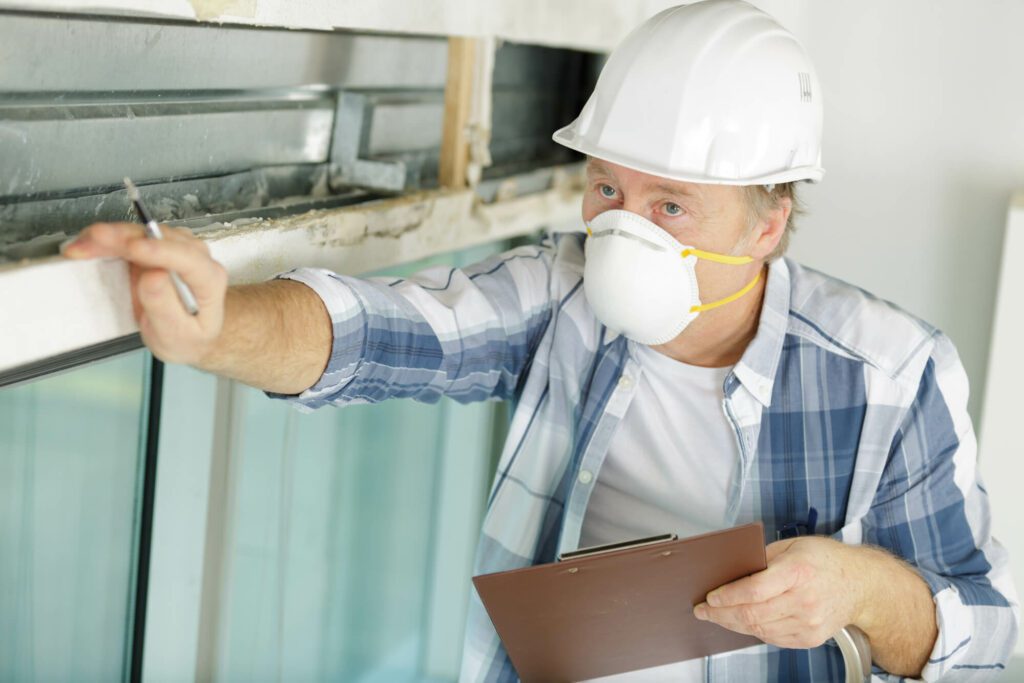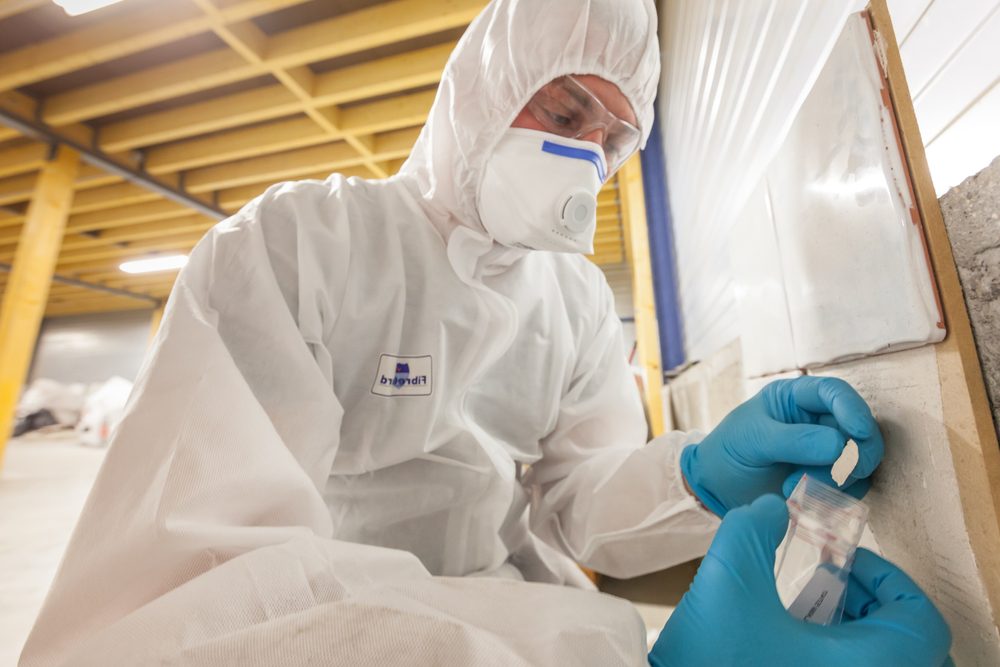Ticking Time Bomb: What You Need to Know About Asbestos
Asbestos, a naturally occurring mineral, was once widely used in construction materials and insulation due to its strength, durability, and heat resistance. However, the microscopic fibers present a hidden danger that people can quickly inhale, resulting in serious respiratory problems, such as asbestos-related lung cancer and mesothelioma — a type of cancer that affects the lining of the lungs and the protective layer surrounding the lower digestive tract.
As awareness grew regarding these health hazards, many countries now ban or heavily restrict the use of asbestos in new products. What makes asbestos particularly unsafe is its capacity to release minute, airborne fibers when disturbed or damaged. Inhaling these airborne fibers can lead to the onset of asbestos-related diseases.

Is Asbestos Lurking in Your Home? Spot the Signs Before It’s Too Late
One of the first steps to identify potential asbestos in your home is to determine the age of the building. Buildings constructed before the 1980s commonly contain asbestos, such as insulation, ceiling tiles, vinyl flooring, and roof shingles. Suppose you suspect that your home has asbestos-containing materials. In that case, you should avoid disturbing them and immediately call a professional asbestos abatement company.
Another way to identify potential asbestos in your home is to look for signs of deterioration or damage in the specified building materials. Asbestos-containing materials can release dangerous fibers into the air when damaged or corrupted, leading to increased health risks. You may hire a professional inspector to assess your home’s materials visually.
You can also conduct a DIY test by collecting a small sample of the material you suspect contains asbestos and sending it to an accredited laboratory for analysis. Remember that it’s necessary to handle the material safely, wear protective gear, and follow proper disposal protocols to prevent exposure.
Need a mold inspection? We have you covered!
DIY Asbestos Removal: A Step-by-Step Guide
Wear Protective Gear
To safely handle small amounts of asbestos, homeowners must prioritize protective measures. This step involves equipping yourself with essential gear like a respirator mask, eye protection, gloves, and a full-body suit. Ensure the respirator mask is rated explicitly for asbestos particles, while the suit effectively blocks asbestos fibers with its material. Before commencing any work, always ensure the protective gear fits correctly and is in excellent condition. Adopting these precautions can successfully remove asbestos while safeguarding your well-being.
Wet the Area
Thoroughly wet the area with water before you begin working with asbestos to minimize the presence of airborne asbestos fibers during removal. Additionally, continue spraying water on the spot as you work to prevent the dispersal of dust and debris. Once your task is complete, grab a damp cloth or mop and give all surfaces a good wipe down to remove any remaining particles. By following these measures, you can confidently mitigate potential health risks associated with asbestos exposure.
Use Appropriate Tools
When removing small amounts of asbestos, using tools specifically designed for this purpose is required. This step includes utilizing a vacuum cleaner with a HEPA filter and tools like scrapers and putty knives that minimize dust when used on hard surfaces such as walls and ceilings. Moreover, avoid using power tools like drills or saws, which can generate hazardous dust when working with asbestos.
Dispose Properly
Proper disposal of asbestos is crucial after removal to prevent exposure and contamination. All asbestos-containing materials should be securely placed in sealed plastic bags and taken to specialized facilities for hazardous waste disposal. Refrain from mixing asbestos materials with other waste, as this increases the risk of contamination for future handlers. Safely handling asbestos ensures a safer environment for all.
Seek Professional Assistance
Suppose you need help in removing small amounts of asbestos safely. In that case, it’s best to seek assistance from an experienced contractor specializing in hazardous materials. They have access to specialized equipment and training to ensure strict adherence to safety protocols during removal and disposal. This procedure ensures that everyone involved remains safe, giving you peace of mind.
Finishing the Job: Asbestos Post-Removal Protocol
Asbestos removal is a complex and typically costly task that requires professional expertise. After removing the hazardous materials from a building or site, the post-removal process starts. One crucial step is air testing, which involves measuring the amount of asbestos fibers in the air to ensure they are below the legal limit, and a qualified technician should conduct the air test using specialized equipment.
Disposal methods for asbestos-containing materials (ACMs) are also critical in ensuring public health and safety. Regulations vary across different regions. Still, standard practices include double-bagging and sealing the ACMs in a secure container, followed by transportation to a licensed landfill for disposal. Improper handling and disposal of ACMs underscore the importance of proper disposal, as they can release asbestos fibers into the air and cause various lung diseases.
Overall, ensuring that our homes do not discharge asbestos into the environment and that people and places are safe from its harmful effects requires the compulsory post-removal process of asbestos removal, which includes conducting air testing and implementing proper disposal methods.
Quick-Fix Solution: Alternative Treatment Options for Asbestos
Professional asbestos removal is the most recommended method to eliminate asbestos from a property safely, but the associated cost can be prohibitive to homeowners and small businesses. Fortunately, alternative methods for asbestos removal can be both practical and economical. One such method is encapsulation, wherein a durable coating is applied to the asbestos material to prevent the release of hazardous fibers. Another option is to cover the asbestos by installing new materials, such as drywall or tiles. However, it is worth noting that these methods should only be considered by trained professionals, as improper removal can cause health hazards and lead to illegal implications. It’s always better to rely on experts with specialized tools and equipment to detect and efficiently remove asbestos.
Asbestos Removal: Must-Know Hiring Tips
Research Potential Contractors
When it comes to asbestos removal, a responsible homeowner must dedicate time to researching potential contractors. Begin by seeking referrals from friends and family who have dealt with asbestos removal previously. Additionally, browsing online for local asbestos removal contractors and reading customer reviews on reputable sites can provide insights into their reputation. Moreover, remember to verify their licensing and insurance before hiring.
Don’t Hesitate to Ask Questions
After narrowing down your list of potential inspectors, you must inquire about their experience and qualifications for asbestos removal. Ensure they are well-versed in safety protocols, including wearing protective gear and correctly disposing hazardous materials. Furthermore, remember to ask about the estimated cost of the project and any possible additional fees.
Get Multiple Estimates
Gathering estimates from multiple companies is crucial when deciding on a contractor to hire. This hiring step allows you to compare prices and services, facilitating an informed decision that aligns with your needs and budget. By obtaining multiple estimates, you can prevent overpaying or falling victim to untrustworthy contractors. So, take charge and make a wise choice for your project!
Asbestos Removal is Only the Beginning!
Asbestos removal is necessary to guarantee the safety of individuals who come into contact with materials that contain the substance. However, homeowners must also understand the importance of frequent maintenance after asbestos removal because asbestos fibers can remain on surfaces and in the air, even after removal. Therefore, regular cleaning and maintenance are required to prevent potential exposure to lingering asbestos fibers. It is also vital to keep records of maintenance and inspections and plan to manage any possible asbestos exposure.
Take One Step Towards Safety With Our Expert Asbestos Removal
Experts generally recommend having hazardous asbestos in your home removed by an expert, as it can pose a severe health hazard. While Delmarva Inspections Group does not revove asbestos, they have experienced certified inspectors who can locate it with the utmost professionalism and attention to detail. Ultimately, locating asbestos and testing for it is the first step in eliminating the exposure for you and your family. Taking care of asbestos removal helps protect your family’s well-being and increases the value of your home when it comes time to sell. So don’t delay — schedule an appointment with Delmarva Inspections Group today and discover any unknowns that might be lurking in your home.


















